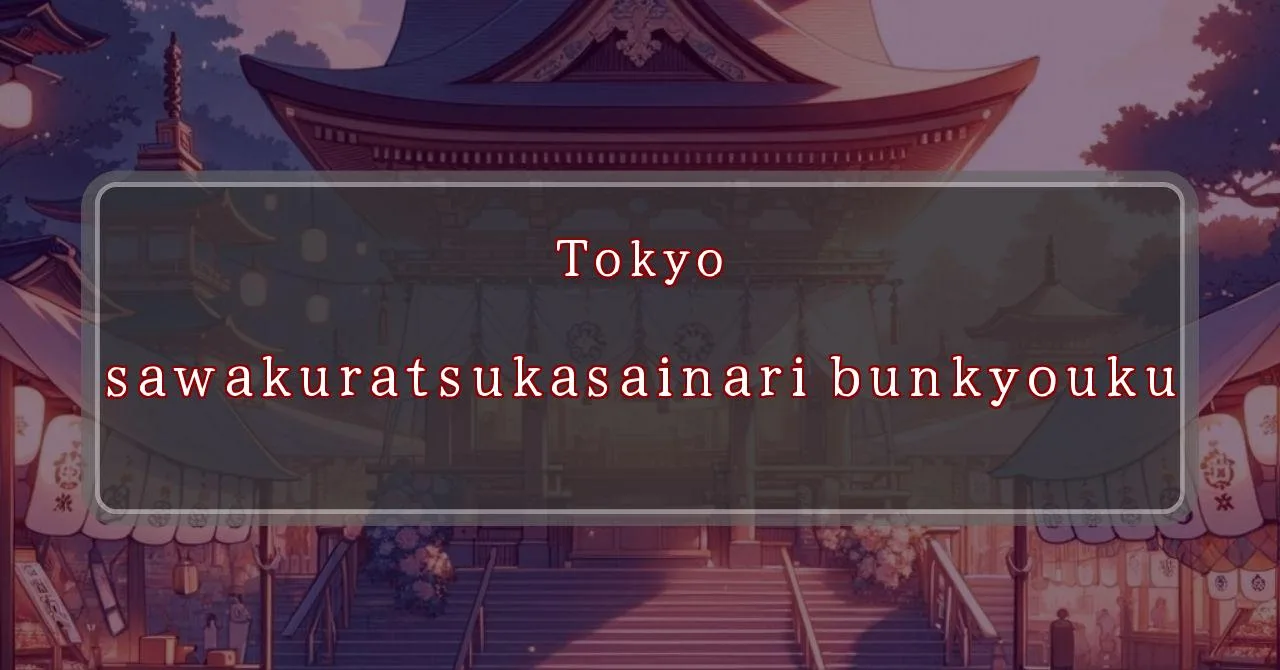Enchanting Shrine Festival in Tokyo: A Journey Through History and Tradition
Basic Information
Takuzōsu Inari Shrine is a Shinto shrine located in Koishikawa, Bunkyo Ward, Tokyo, Japan. It is dedicated to Inari, the Shinto deity of rice and sake, and is known for its annual festival, the Takuzōsu Inari Matsuri.
- Address: 3-17-12 Koishikawa, Bunkyo-ku, Tokyo 112-0002
- Phone Number: 03-3811-1327
- Access: 8-minute walk from Kasuga Station on the Tokyo Metro Marunouchi Line and Namboku Line, or a 10-minute walk from Korakuen Station on the Tokyo Metro Marunouchi Line and Namboku Line.
- Festival Days: May 7th and 8th, 2024
Main Events and Attractions of the Festival
The Takuzōsu Inari Matsuri is a lively and colorful festival that attracts many visitors each year. The main events and attractions of the festival include:
Mikoshi Procession
A mikoshi (portable shrine) is carried through the streets of the neighborhood, accompanied by music and dancing. The mikoshi is believed to be inhabited by the spirit of the deity, and carrying it is considered a great honor.
Kagura Performance
Kagura is a traditional Japanese dance and music performance that is often performed at Shinto shrines. The dances are typically performed by young women, and they tell stories from Japanese mythology.
Food Stalls
A variety of food stalls are set up at the festival, selling everything from traditional Japanese dishes to international cuisine. There are also many stalls selling souvenirs and crafts.
Bonfire
On the evening of the festival, a large bonfire is lit in the shrine grounds. People gather around the bonfire to pray for good luck and to ward off evil spirits.
Fireworks Display
The festival concludes with a spectacular fireworks display. The fireworks are launched from a nearby park, and they light up the night sky with their vibrant colors.
Blessings and Deities
Takuzōsu Inari Shrine is dedicated to Inari, the Shinto deity of rice and sake. Inari is also known as the god of fertility, prosperity, and worldly success. The shrine is believed to have been founded in 1620 by a senior monk of the Jōdo-shū Buddhist sect named Kakuzan. Kakuzan claimed that he was visited by Inari in a dream, who told him to establish a shrine in his honor. The shrine has been a popular place of worship for centuries, and it is said that many people have received blessings from Inari, including good harvests, financial success, and happiness in their personal lives.
Origin and History
The origins of Takuzōsu Inari Shrine can be traced back to the early 17th century. In 1620, a senior monk of the Jōdo-shū Buddhist sect named Kakuzan claimed that he was visited by Inari in a dream. Inari told Kakuzan to establish a shrine in his honor, and so Kakuzan founded Takuzōsu Inari Shrine on the grounds of Denzū-in Temple in Koishikawa, Bunkyo Ward, Tokyo.
The shrine was originally a small shrine, but it gradually grew in popularity over the years. In the 19th century, the shrine was rebuilt and expanded, and it became a popular destination for pilgrims and worshippers from all over Japan.
Tips and Notes for Visitors
Here are some tips and notes for visitors to Takuzōsu Inari Shrine:
- The shrine is open from 9:00 AM to 5:00 PM every day.
- Admission to the shrine is free.
- There is a small museum on the shrine grounds that displays artifacts related to the history of the shrine.
- There is a gift shop on the shrine grounds where you can purchase souvenirs and amulets.
- The shrine is a popular destination for weddings and other ceremonies.
- If you are visiting the shrine during a festival, be sure to check out the food stalls and other attractions.
Parking Information
There is no parking lot at Takuzōsu Inari Shrine. However, there are several public parking lots located nearby.
- Kasuga Parking Lot: This parking lot is located a 5-minute walk from the shrine.
- Korakuen Parking Lot: This parking lot is located a 10-minute walk from the shrine.
- Koishikawa Parking Lot: This parking lot is located a 15-minute walk from the shrine.
Popular Stalls and Food Carts in Recent Years
| Type of Stall | Description |
|---|---|
| Takoyaki | A staple at Japanese festivals. Characterized by a crispy outside and a creamy inside. |
| Jaga Butter | A simple yet popular snack of hot potatoes lavishly topped with melted butter. |
| Baby Castella | Small castella cakes, sweet and fluffy treats enjoyed by children and adults alike. |
| Grilled Ayu with Salt | Fresh ayu fish grilled whole with salt, a savory taste of Japanese summer. |
| Shaapin | A unique gourmet item influenced by foreign cuisine, with a chewy skin wrapping the filling. |
| Okonomiyaki | A Japanese grilled dish where you often choose your own ingredients for a personalized flavor. |
| Cotton Candy | A fluffy, sweet snack that’s extremely popular with children. |
| Chocolate Banana | A banana coated in chocolate, a fun and visually appealing dessert. |
| Kushiyaki | Various types of ingredients skewered and grilled, an easy-to-enjoy snack. |
| Yakisoba | Fried noodles mixed with a special sauce, a fast food favorite in Japan. |



